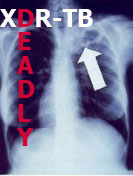
Extensively Drug Resistant TB (XDR-TB) is an emerging killer that is virtually untreatable. World wide, 9 million people contract TB each year, and 1.7 million of them die. Typically TB is treated with first and second line drugs. XDR-TB is resistant to the first line drugs as well as most of the second line drugs. There are no third line drugs for TB at this time. This new strain is found in many countries, including the US. Right now it is preying upon HIV positive patients in South Africa. In one South African ward, 52 of 53 patients infected with XDR-TB died. And they died quickly, within 25 days of diagnosis.
Part of the problem is the nature of South Africa's inadequate health care. 50% of South Africans treated for TB will find themselves back at the hospital again because their treatment failed. The longer these people stay in the hospital, the more likely they are to come in contact with, and contract, XDR-TB. In essesnce, the South African situation appears to be an instance of Hospital Acquired Infection. That's where Ultraviolet Germicidal Irradiation could play a role.
UVGI was a regular method of TB control in the US for many years. Upper room UV deactivates TB and prevents the virulent bacteria from infecting people via the air. As effective drugs were developed, UV fell out of vogue. But UVGI plays a unique role in fighting infectious disease. Virulent viruses and bacteria are programmed to find ways to adapt to medicines that stop them. Over time, drugs lose their effectiveness and contribute to creation of drug resistant microorganisms.
UVGI is a prophylactic barrier. The use of UV radiation to prevent DNA and RNA from being able to replicate is not something that a microorganism can adapt to and circumvent. Of course, certain organisms are more resistant to UV and take a larger dose for inactivation (e.g. spores). However, an organism's suseptibility to UV doesn't change or grow more resistant. Once engineers know the dose needed to inactivate a microorganism, UV systems can be designed with sufficient exposure to get the job done.
So far we are unable to find any reports of the use of UV in South Africa to fight XDR-TB. Given that doctors involved in this crisis say XDR-TB is a nosocomial phenomenon, it would appear that UVGI could help contain a threat that is more immediate and more deadly than exisitng strains of H5N1.
XDR-TB TB South+ Africa UVGI UV Vigilair airborne+transmission


No comments:
Post a Comment